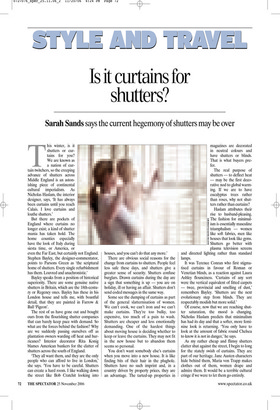Is it curtains for shutters?
Sarah Sands says the current hegemony of shutters may be over This winter, is it shutters or curtains for you? We are known as a nation of curtain twitchers, so the creeping advance of shutters across Middle England is an astonishing piece of continental cultural imperialism. As Nicholas Haslam, the interior designer, says, ‘It has always been curtains until you reach Calais. I love curtains and loathe shutters.’ But there are pockets of England where curtains no longer exist; a kind of shutter mania has taken hold. The home counties especially have the look of Italy during siesta time, or America, or even the Far East, but certainly not England. Stephen Bayley, the designer-commentator, points to Parsons Green as ‘the scriptural home of shutters. Every single refurbishment has them. Louvred and anachronistic.’ Bayley speaks from a position of historical superiority. There are some genuine native shutters in Britain, which are the 18th-century or Regency ones. Bayley has these in his London house and tells me, with boastful detail, that they are painted in Farrow & Ball ‘Pigeon’.
The rest of us have gone out and bought ours from the flourishing shutter companies that can barely keep pace with demand. So what are the forces behind the fashion? Why are we suddenly passing ourselves off as plantation owners warding off heat and hurricanes? Interior decorator Rita Konig blames American bankers for the clatter of shutters across the south of England.
‘They all want them, and they are the only people who can afford to live in London,’ she says. ‘You have to be careful. Shutters can create a hard room. I like walking down the street like Bob Cratchit looking into houses, and you can’t do that any more.’ There are obvious social reasons for the change from curtains to shutters. People feel less safe these days, and shutters give a greater sense of security. Shutters confuse burglars. Drawn curtains during the day are a sign that something is up — you are on holiday, ill or having an affair. Shutters don’t send coded messages in the same way.
Some see the dumping of curtains as part of the general slatternisation of women. We can’t cook, we can’t iron and we can’t make curtains. They’re too bulky, too expensive, too much of a pain to wash. Shutters are cheaper and less emotionally demanding. One of the hardest things about moving house is deciding whether to keep or leave the curtains. They may not fit in the new house but to abandon them seems so personal.
You don’t want somebody else’s curtains when you move into a new house. It is like finding bits of their hair in the plughole. Shutters have no such imprint and, in a country driven by property prices, they are an advantage. The tarted-up properties in magazines are decorated in neutral colours and have shutters or blinds. That is what buyers prefer.
The real purpose of shutters — to deflect heat — may be the first decorative nod to global warming. If we are to have eucalyptus trees rather than roses, why not shutters rather than curtains?
Haslam attributes their rise to husband-pleasing. The fashion for minimalism is essentially masculine triumphalism — women like soft fabrics, men like houses that look like gyms. Shutters go better with plasma television screens and directed lighting rather than standard lamps.
It was Terence Conran who first stigmatised curtains in favour of Roman or Venetian blinds, as a reaction against Laura Ashley flounciness. ‘Curtains of any sort were the vertical equivalent of fitted carpets — twee, provincial and smelling of dust,’ remembers Bayley. ‘Shutters are the next evolutionary step from blinds. They are respectably modish but more solid.’ Of course, now that we are reaching shutter saturation, the mood is changing. Nicholas Haslam predicts that minimalism has had its day and that a softer, more feminine look is returning. ‘You only have to look at the amount of fabric round Chelsea to know it is not in danger,’ he says.
As my rather cheap and flimsy shutters clatter shut against the street, I begin to long for the stately swish of curtains. They are part of our heritage. Jane Austen characters hide behind them, Maria von Trapp makes clothes out of them, women drape and admire them. It would be a terrible cultural cringe if we were to let them go entirely.
DAVID MONTGOMERY


























































































 Previous page
Previous page